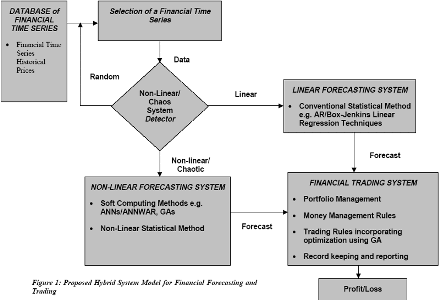Figure 1 in this page shows the overall model of the proposed hybrid system incorporating chaos theory, artificial intelligence/soft computing and statistical methods for financial forecasting and trading. We intend to use historical Australian and international stock market prices and foreign exchange rates to test our forecasting models and the trading system.
First Phase:-Selection of Financial Time Series using Chaos Theory
The first phase of the project will attempt to develop a methodology to select the financial time series data that has the most potential of being modeled to obtain abnormal returns. We hypothesize that if a financial time series is not random, but behaves in a random-like manner, it may be chaotic (hence, deterministic) and thus may be modeled by non-linear statistical or ANN models.
The first phase outcome will be a methodology to identify financial time series that may be deterministic or chaotic. Only financial time series that exhibit this behavior will be used in the second phase of the project, which is developing the forecasting model. We will assume that data that have been analyzed in phase one that are not deterministic are stochastic or random and hence, will not be considered for the forecasting models in the next phase of the research. We will assume that the one dimensional time series is a projection from a multidimensional system. Therefore we need to reconstruct the series, to its true dimension.
We will reconstruct the time series using the time delay and the embedding dimension parameters. Processing starts with the non-linear system detector part, consisting of various functional criteria. One of the function is to measure the Hurst exponent value (H) to determine whether the number of data set is adequate for measuring the Hurst exponent, and then calculating the mean orbital period and the overall nature of the time series, in other words its persistency and antipersistency nature. We will analyze the methods of measuring the Hurst such as choosing a good compressor value, (i.e., log return is a very high compressor) for the time series, averaging for different N, thus removing the AR residual part, and the first peak from the data set of log(R/S) and Log(N).
From the value of H, we will then decide the type of model to use for fitting, i.e. a short term (e.g. ARIMA) or a long term (e.g. FARIMA) model. The other functions that we will investigate are average mutual information, calculation of the minimum embedding dimension, and time delay to reconstruct the phase space. The simplest method of measuring the time delay is from the peak-topeak analysis or time domain auto-correlation function. The system predictability is measured from recurrent analysis, rather than the time delay plot, on the basis of a parameter called spectral entropy.
It is a very useful measure for selection of a financial time series from the historical database. We will attempt to develop a model, which preprocess the data in varying time window size, window gap and measure the dynamic nature of the system. We will then fit the appropriate model to that particular time frame. The idea is based on the concept that a time series changes its basic nature in mainly three forms: trending, chaotic or random. The change in the dynamic nature of the system is detected by calculating the largest Lyapunov exponent for different time window size. We will also investigate how the prediction error can be determined from the value of Lyapunov exponent.

Prof. Clarence N W Tan
Next: Second Phase:- Financial Forecasting Models using Non-linear Statistical and Soft Computing Methods
Summary: Index